What Is the Degrees to Radians Conversion?
Any angle in degrees can be converted into radians using the degrees to radians conversion. The relationship between degrees and radians is given as
Degree and radian are the units for measuring an angle. An angle is a geometric figure formed when two rays meet at a common point, called vertex. When the angle is measured counterclockwise, it is called a positive angle. Angle measured in a clockwise direction is called a negative angle.
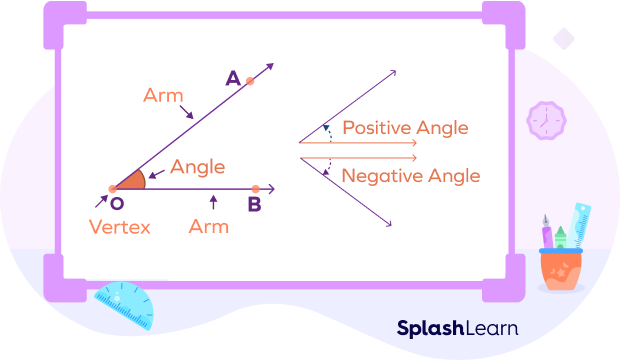
What Are Degrees?
A degree (°) is a unit for measuring the magnitude of an angle. It is the SI unit to measure angles.
The measure of an angle in degrees is determined by the amount of rotation from the initial side to the terminal side. One complete counterclockwise rotation is
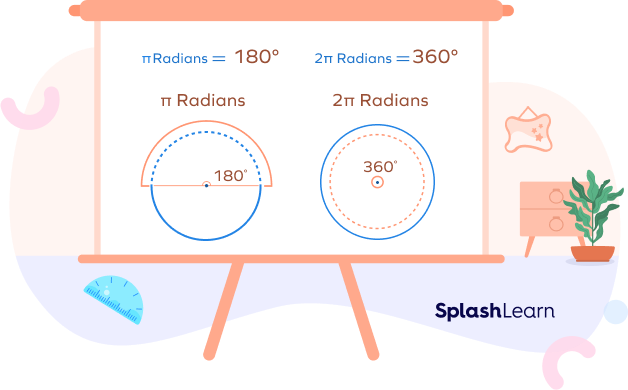
What Are Radians?
Radian is an SI unit used to measure angles. Radian is sometimes denoted by a “c” in the exponent, or by writing rad in the front of the measurement. For example, 2 radian is written as
One radian is the angle where the arc length equals the radius. The formula for angle in radians is
For example, consider a unit circle (circle with radius 1 unit). An angle subtended at the center by an arc with a length of 1 unit has the measure of 1 radian.
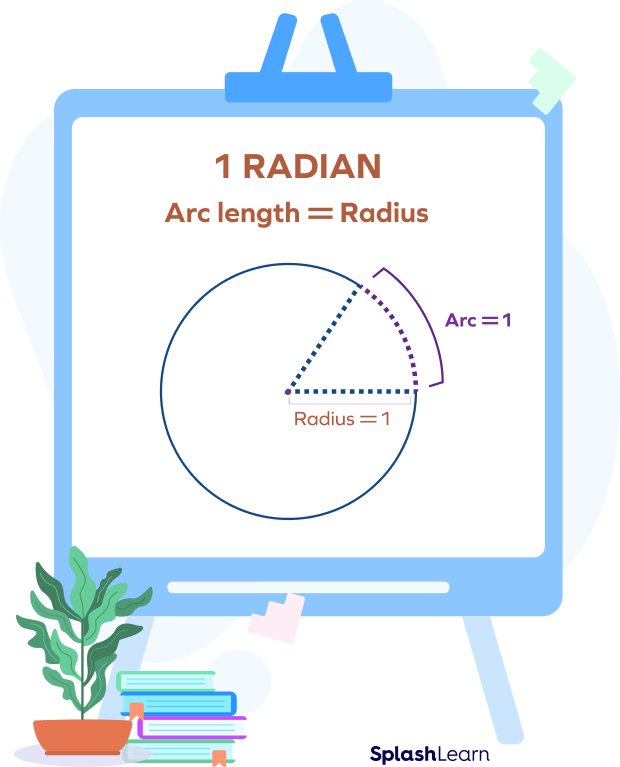
Note that all circles are similar. Thus, the measure of an angle in radians is the same regardless of the size of the circle. So, for any circle, if radius = arc length, the angle is 1 radian. One radian is approximately equal to 57.296 degrees.
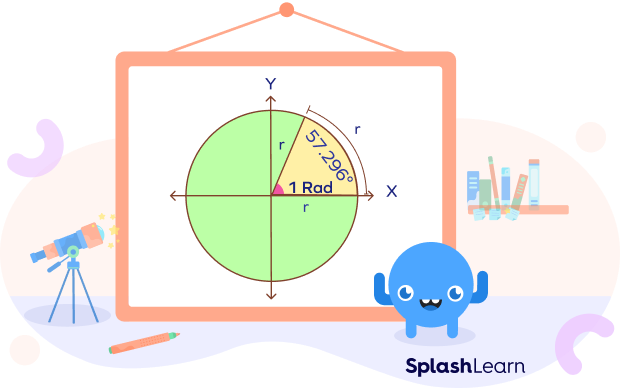
When we are dividing a circle in radians, about 3.14 radians will fit in each half of the circle. So, 6.28 radians will fit in a full circle. The exact amount of radians that fit in half a circle is π, which is about 3.14 radians. So, a full circle fits 2π radians (which is about 6.28 radians).
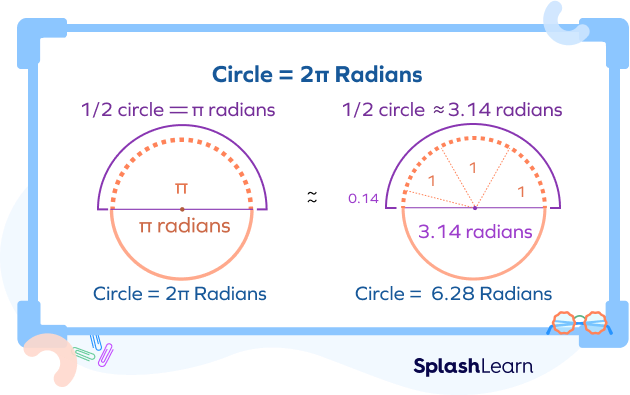
Recommended Games
Degrees to Radians Formula
To convert angle in degrees to radians in terms of , we have to multiply the angle in degrees by
Angle in Radians
Derivation of Degrees to Radians Formula
- One complete counterclockwise revolution in degrees
- One complete counterclockwise revolution in radians
The relationship between degree measure and radian measure can be given as
Hence,
Thus, to convert degrees to radians, the formula is
Angle in Radians
To find the value of
How to Convert Degree Measure to Radian Measure
We know that, 180°= radians. So, how to change degrees to radians? In order to convert any angle from the degree measure to radians, the value in degrees must simply be multiplied by
Angle in Radian
Let’s take a look at a few examples. Convert the given angle measures from degrees to radians in terms of pi.
Degrees to Radians Chart
The degrees to radians chart helps us understand the conversions better.
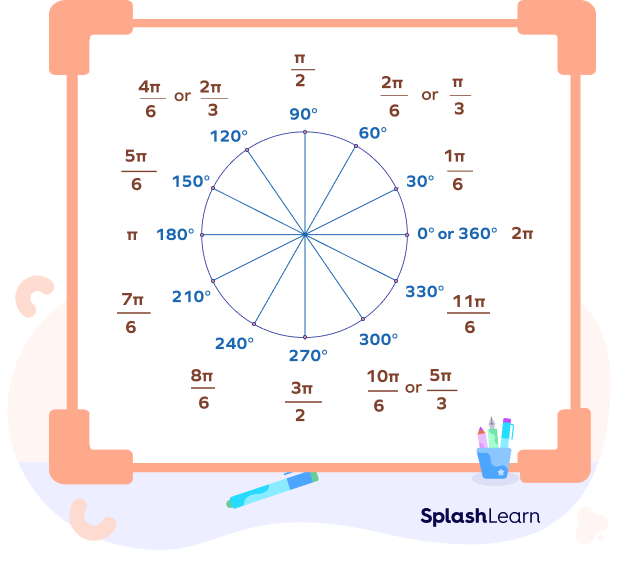
In the chart given above, values of angles are given in degrees as well as the radians that helps to do the calculations faster and easier.
Degrees to Radians Conversion Table
Let’s look at the table with some standard angles in degrees and the corresponding angles in radians.
| Degrees | Radians |
|---|---|
| $$\frac{\pi3}{2}$ | |
Negative Degree to Radians
An angle measured in a clockwise direction is called a negative angle. The method for converting negative degrees to radians is the same as for positive degrees. We simply have to multiply the value of the angle in degrees by
Example: If you need to convert
Angle in radians
Angle in radian
Angle in radians
Facts about Degrees to Radians
- One degree is relatively small compared to one radian.
- The factors of the number 360 are 1, 2, 3, 4, 5, 6, 10, 12, 15, 20, 30, 45, 60, 90, 120, 180, 360. This helps in dividing the circle into equal parts and also to easily understand and compare different angles.
- Degrees and radians are related by the equations
- We can convert angle in degrees to angle in radians and vice versa using the following formulas:
Angle in Degrees
Angle in Radians - The method for converting negative degrees to radians is the same as for positive degrees. We simply have to multiply the value of the angle in degrees by
Conclusion
In this article, we learned about the units, degrees and radians and their interconversions. Let’s solve some examples for better understanding.
Solved Examples on Degrees to Radians
1. Convert each degree measure into radians.
a)
b)
Solution:
Angle in Radians
a)
b)
2. Convert
Solution:
Angle in degrees
Angle in degrees $= \frac{2\pi}{6} \times \frac{180^{\circ}{\pi} = 60^{\circ}$
3. Convert
Solution:
Angle in radians
Angle in radians
Angle in radians
4. Convert
Solution:
Angle in Radians
Angle in radians
Thus,
Practice Problems on Degrees to Radians
Degrees to Radians: Conversion, Steps, Formula, Examples, Facts
How many radians does a complete circle have?
One complete counterclockwise revolution in degrees
One complete counterclockwise revolution in radians
Thus,
Select the incorrect match.
We convert degrees to radians by multiplying by
Thus,
1 degree = ___________ radians
To convert degrees to radians, the derived formula is
_______ is an SI unit used to measure angles.
The SI unit of angle measure is the radian. The degree is not an SI unit, but it is mentioned in the SI brochure as an accepted unit.
Degrees are converted into radians by formula, Angle in radians = _______.
In order to convert any angle from the degree measure to radians, the value must simply be multiplied by
Frequently Asked Questions about Degrees to Radians
What is the measure of 0 radians in degrees?
To convert 0 radians to degrees, we multiply it by
So, 0 radians
Thus, the measure of 0 radian in degrees is zero.
What is the difference between degrees and radians?
Degree measurement is based on the extent of rotation from the initial arm to the terminal arm of an angle. As an observer, degrees indicate how much you tilted your head from the starting point to the end point of the angle.
In contrast, radians measure an angle based on the distance traveled along the circumference of a circle. When the distance traveled is equal to the radius of the circle, it is referred to as 1 radian.
It’s important to note that both degrees and radians are used to quantify angles, but they represent angles in different ways.
What is 1 radian?
One radian is the measure of the central angle spanned by the arc whose arc-length equals radius.




















